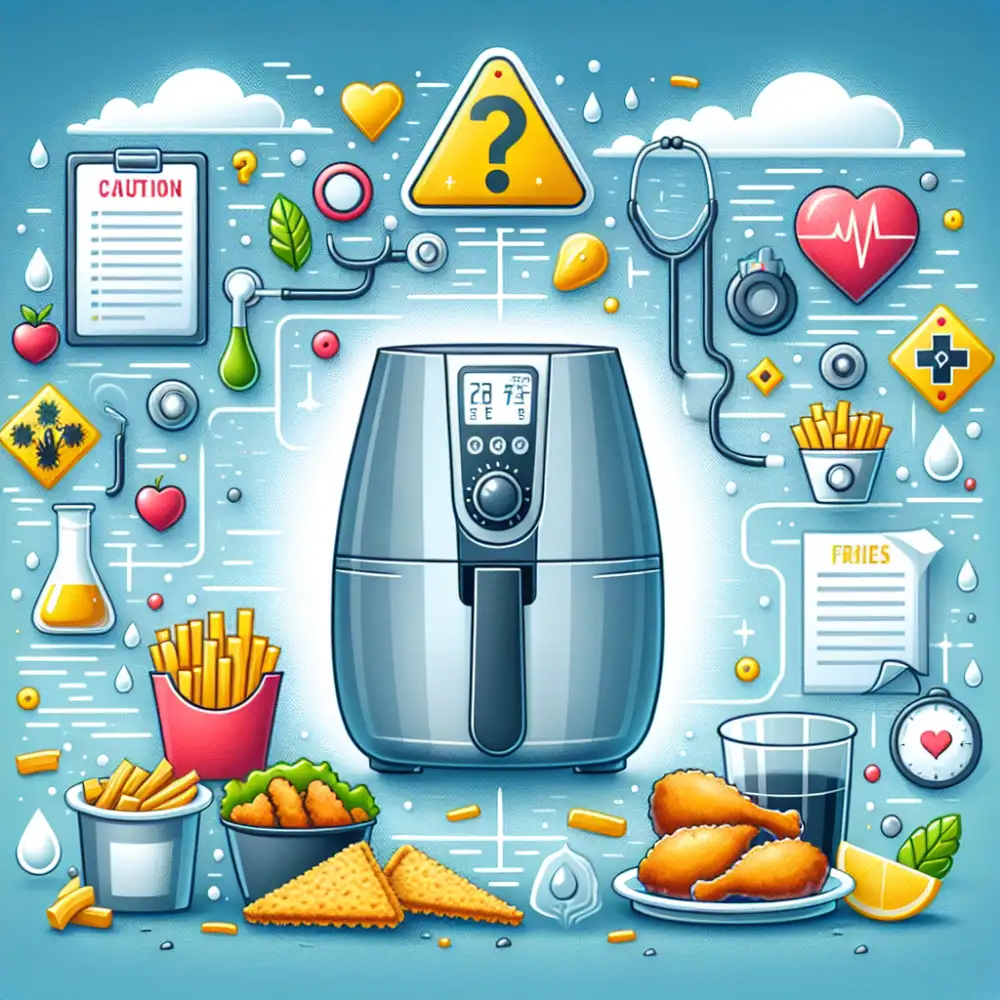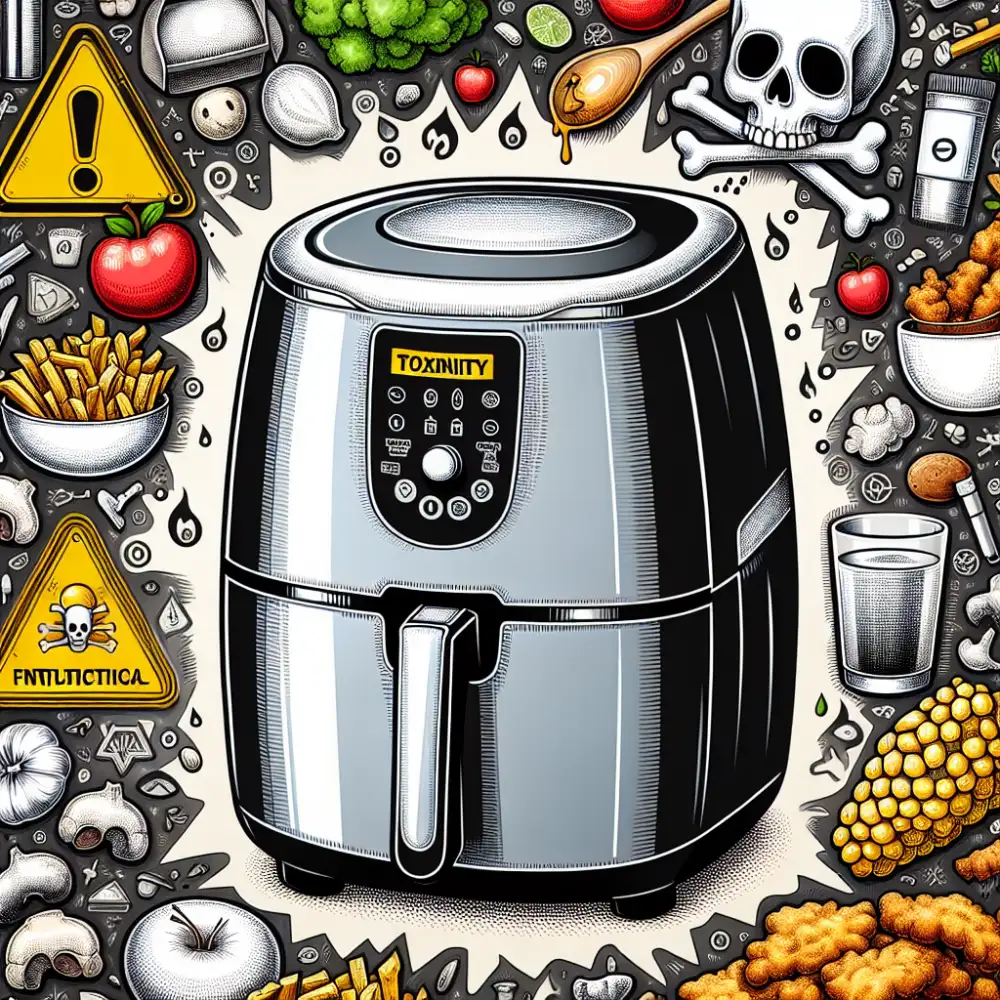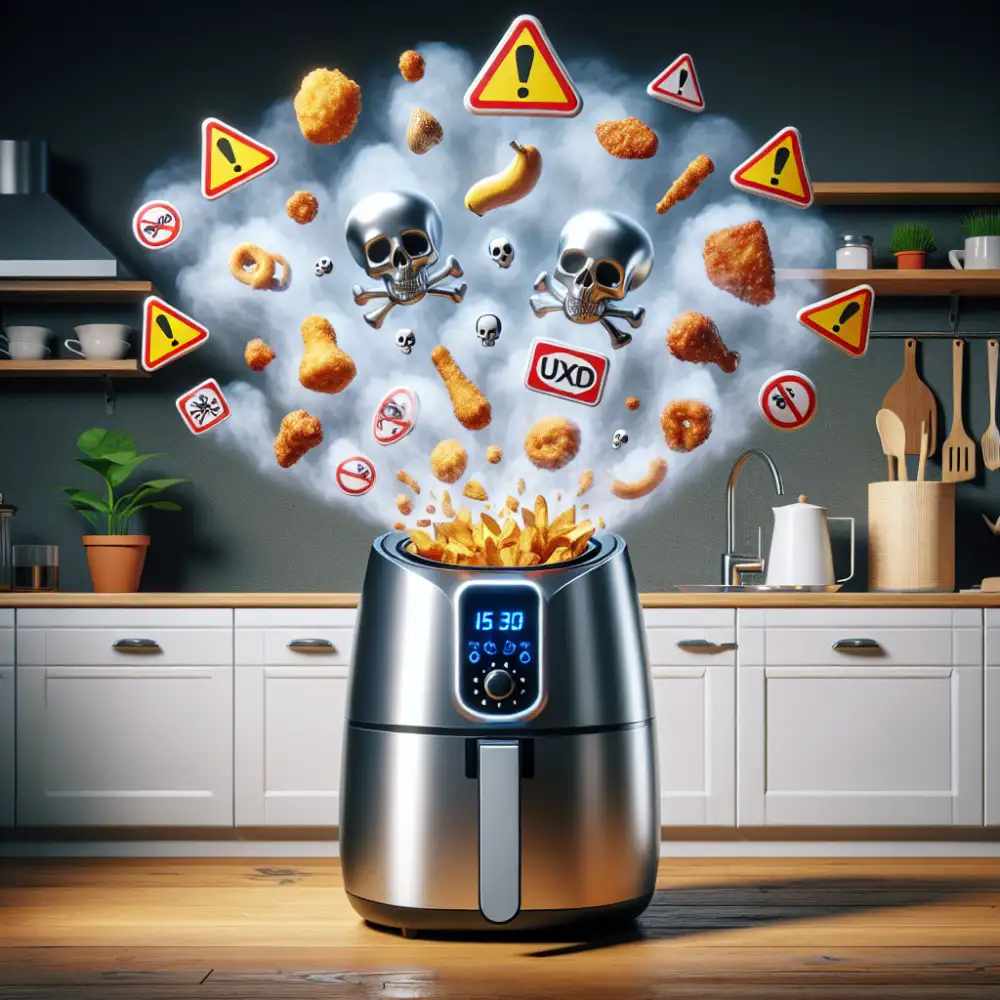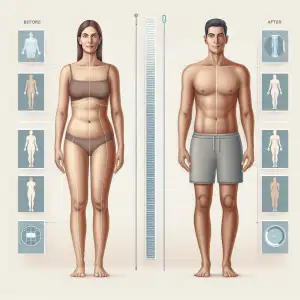Is Your Air Fryer Toxic? What You Need to Know to Stay Safe.

Formation of Acrylamide
Acrylamide is a chemical that forms in some foods during high-heat cooking, such as frying, baking, or roasting. It is formed from the naturally occurring amino acid asparagine and sugars like glucose or fructose. Air fryers, while touted as a healthier alternative to deep frying, can still produce acrylamide. This is because they also cook food at high temperatures, typically between 300°F and 400°F (150°C and 205°C). The exact amount of acrylamide produced in an air fryer varies depending on several factors, including cooking temperature, time, and the type of food being cooked. Starchy foods like potatoes and bread are more likely to form acrylamide during cooking.
While acrylamide formation is a concern, it's important to note that it's not unique to air fryers. The International Agency for Research on Cancer (IARC) classifies acrylamide as "probably carcinogenic to humans" based on studies in animals. However, more research is needed to understand the precise risks of acrylamide intake from foods in humans.
To minimize acrylamide formation when using an air fryer:
Avoid overcooking food.
Cook at slightly lower temperatures if possible.
Store potatoes in a cool, dark place before cooking.
Don't store potatoes in the refrigerator.
Production of PAHs
One concern with air fryers is their potential to produce polycyclic aromatic hydrocarbons (PAHs). PAHs are a group of chemicals that form when meat, poultry, or fish is cooked at high temperatures. This is especially true when these foods are cooked for extended periods, or when fat drips onto the heating element.
While air fryers generally use less heat and cooking time compared to traditional deep frying, studies have shown that they can still produce PAHs. The exact amount generated depends on several factors, including the type of food being cooked, the temperature, and the cooking time.
PAHs are concerning because they have been linked to some health risks. Exposure to high levels of PAHs has been associated with an increased risk of cancer. However, it is important to note that the levels of PAHs produced by air fryers are generally much lower than those produced by other cooking methods, such as grilling over an open flame.
To minimize the potential for PAH formation when using an air fryer, it is recommended to:
Avoid overcooking food
Choose leaner cuts of meat and poultry
Properly preheat the air fryer
Clean the air fryer regularly according to the manufacturer’s instructions
Advanced Glycation End Products
Advanced glycation end products (AGEs) are harmful compounds that form when proteins or fats react with sugars at high temperatures. This process, known as the Maillard reaction, is what gives fried and grilled foods their characteristic browning and flavor. While AGEs are present in many foods, cooking methods like deep frying and grilling can significantly increase their formation.

Air fryers, marketed as a healthier alternative to deep frying, use hot air to cook food with minimal oil. This has led to questions about whether air fryers also produce AGEs. While air fryers generally cook food at lower temperatures than deep frying, studies have shown that they can still produce AGEs, albeit potentially in lower amounts. The exact levels of AGEs formed depend on factors like cooking time, temperature, and the type of food being cooked.
Consuming high levels of AGEs has been linked to an increased risk of various health problems, including:
- Inflammation
- Insulin resistance
- Type 2 diabetes
- Heart disease
- Kidney disease
- Alzheimer's disease
It's important to note that more research is needed to fully understand the long-term health effects of AGEs from air fryers.
However, to minimize potential risks, it's advisable to:
- Cook food at lower temperatures
- Avoid overcooking
- Choose leaner cuts of meat
- Use marinades containing lemon juice or vinegar, which may help reduce AGE formation
Remember, moderation and balance are key to a healthy diet. While air fryers can be a convenient cooking tool, they should be used in conjunction with other healthy cooking methods and a balanced diet.
Loss of Nutrients
While air fryers excel at creating crispy textures with minimal oil, some worry about potential nutrient loss compared to traditional cooking methods. One concern is the impact of heat on water-soluble vitamins like vitamin C and B vitamins, which are sensitive to high temperatures and prolonged cooking times.
Air fryers, however, often cook food quicker than conventional ovens due to their compact size and circulating hot air, potentially mitigating this risk. Another concern is the potential for oxidation of healthy fats during the air frying process due to the high heat.
While some oxidation is normal during cooking, using the right temperature and avoiding overcrowding the air fryer basket can help minimize this. It's important to note that research on nutrient loss in air fryers is still limited, and further studies are needed to draw definitive conclusions.
While air fryers offer a healthier alternative to deep frying, it's crucial to acknowledge that the high heat used, especially with certain oils, can produce compounds like acrylamide, which have potential links to increased cancer risk. Moderation and informed use are key.
Dr. Evelyn Wright
Risks of Overconsumption
While air fryers offer a healthier alternative to deep frying, it's important to be mindful of potential risks associated with overconsumption of air-fried foods. Air fryers work by circulating hot air around food, creating a crispy texture with minimal oil. However, this cooking process can still lead to the formation of potentially harmful compounds.

One concern is the production of acrylamide, a probable human carcinogen that forms in starchy foods during high-heat cooking. While acrylamide formation is not unique to air fryers, it's essential to use them responsibly and avoid overcooking. Additionally, consuming excessive amounts of fried foods, even when air-fried, can contribute to health issues like high cholesterol, obesity, and heart disease.
Moderation and a balanced diet are key when incorporating air-fried foods into your meals. To minimize potential risks, cook food at recommended temperatures and durations, avoid overcrowding the air fryer basket, and choose lean protein sources and fresh vegetables as part of a well-rounded diet. As with any cooking method, responsible use and mindful consumption are crucial for enjoying the benefits of air-fried foods while safeguarding your health.
Potential for Burns
One potential risk associated with air fryers is the potential for burns. Air fryers heat up to high temperatures, typically around 400 degrees Fahrenheit, to cook food quickly and evenly. While this high heat is essential for the air frying process, it also poses a burn risk if the appliance is not handled carefully. The exterior of an air fryer can also become very hot during use, especially the cooking basket and tray. Touching these hot surfaces can cause skin burns. Additionally, hot air and steam are released from the air fryer during and after cooking. Contact with this hot air or steam can also lead to burns. To minimize the risk of burns, it's crucial to follow safety precautions. Always use oven mitts or heat-resistant gloves when handling the air fryer, especially the cooking basket, tray, and interior surfaces. Avoid touching the air fryer while it's in use and allow it to cool down completely before handling or cleaning. Keep a safe distance from the air fryer while it's in operation to avoid contact with hot air or steam. Remember, exercising caution and following safety guidelines can significantly reduce the risk of burns associated with using an air fryer.
Impact on Existing Conditions
While air fryers offer a seemingly healthier way to enjoy fried foods, it's important to acknowledge their potential impact on existing health conditions. Individuals with respiratory issues, such as asthma or COPD, may experience exacerbated symptoms due to the emission of ultrafine particles during the cooking process. These microscopic particles can irritate the airways, potentially triggering coughing, wheezing, or shortness of breath. Moreover, individuals with cardiovascular disease should exercise caution, as some studies suggest a possible link between exposure to ultrafine particles and an increased risk of heart attacks and strokes. It's crucial to consult with a healthcare professional if you have any pre-existing health conditions and are considering using an air fryer. They can provide personalized advice based on your specific circumstances and help you make informed decisions about incorporating this cooking appliance into your diet.


Importance of Moderation
While air fryers offer a healthier alternative to deep frying, moderation is key. Like any cooking method, excessive use can have potential drawbacks. Air fryers utilize high heat, which, if overused, may contribute to the formation of acrylamide, a potential carcinogen, in starchy foods.
However, it's important to note that acrylamide formation occurs in various cooking methods involving high temperatures. The key is to use the air fryer judiciously and not rely on it for every meal. Variety in cooking methods is crucial for a balanced diet.
Furthermore, ensure you're using the air fryer correctly. Overcrowding the basket can lead to uneven cooking and potentially expose food to higher temperatures for longer durations. Always follow the manufacturer's instructions for optimal use and temperature recommendations.
Remember, balance and moderation are vital for a healthy lifestyle. Enjoy the convenience and benefits of air-fried meals as part of a diverse diet and healthy cooking practices.
Choosing Safe Materials
When it comes to kitchen appliances, safety should be a top priority. This is especially true for air fryers, which use high heat to cook food. One important factor to consider is the materials used in the construction of the air fryer. Some materials can release harmful chemicals when heated to high temperatures, potentially contaminating your food and posing health risks.
Look for air fryers that are made from safe and durable materials. Stainless steel is a popular choice because it is resistant to rust, corrosion, and high heat. It is also relatively inert, meaning it is less likely to leach chemicals into your food. Another safe option is ceramic-coated air fryers. These coatings are typically free of harmful chemicals like PFOA and PTFE and can withstand high temperatures without breaking down.
Avoid air fryers that use non-stick coatings that contain PFOA or PTFE. These chemicals have been linked to health problems, and they can be released from the coating when heated to high temperatures. If you are using an air fryer with a non-stick coating, be sure to follow the manufacturer's instructions carefully. Avoid using metal utensils in your air fryer, as these can scratch the coating and release harmful chemicals.

By choosing an air fryer made from safe materials and using it responsibly, you can enjoy delicious and healthy fried foods without putting your health at risk.
Proper Use and Cleaning
To minimize potential health risks associated with air fryer use, proper use and cleaning are essential. Always follow the manufacturer's instructions for your specific model.
Use the air fryer on a stable, heat-resistant surface, away from flammable materials. Avoid overcrowding the basket, as this can lead to uneven cooking and potential burning. Ensure adequate airflow by not blocking the air vents.
Regular cleaning is crucial to prevent the buildup of grease and food debris, which can smoke, burn, and potentially release harmful chemicals. Allow the air fryer to cool completely before cleaning. Wash the basket and pan thoroughly with warm, soapy water after each use. For stubborn stains, soak the components in soapy water before scrubbing. Clean the heating element and the interior of the air fryer with a damp cloth. Ensure all parts are completely dry before reassembling and using the air fryer again.
Healthier Cooking Alternatives
While air fryers offer a crispy alternative to deep frying, concerns have been raised about potential health risks. These concerns stem from the formation of acrylamides, potentially harmful compounds that can develop in starchy foods at high temperatures. However, it's important to note that acrylamides can also form with other cooking methods like baking and grilling.
If you're looking for healthier cooking alternatives, consider these options:
Oven Baking: Baking your food in an oven is a classic and reliable method.
Pan-frying with Healthy Oils: Opt for heart-healthy oils like olive oil or avocado oil and use minimal amounts for pan-frying.
Steaming: Steaming is a gentle and nutritious way to cook vegetables, fish, and more, preserving their flavors and nutrients.
Boiling: A simple and effective method for cooking vegetables, grains, and legumes.
Remember that a balanced diet and healthy lifestyle choices are crucial for overall well-being.
Published: 26. 06. 2024
Category: Health



